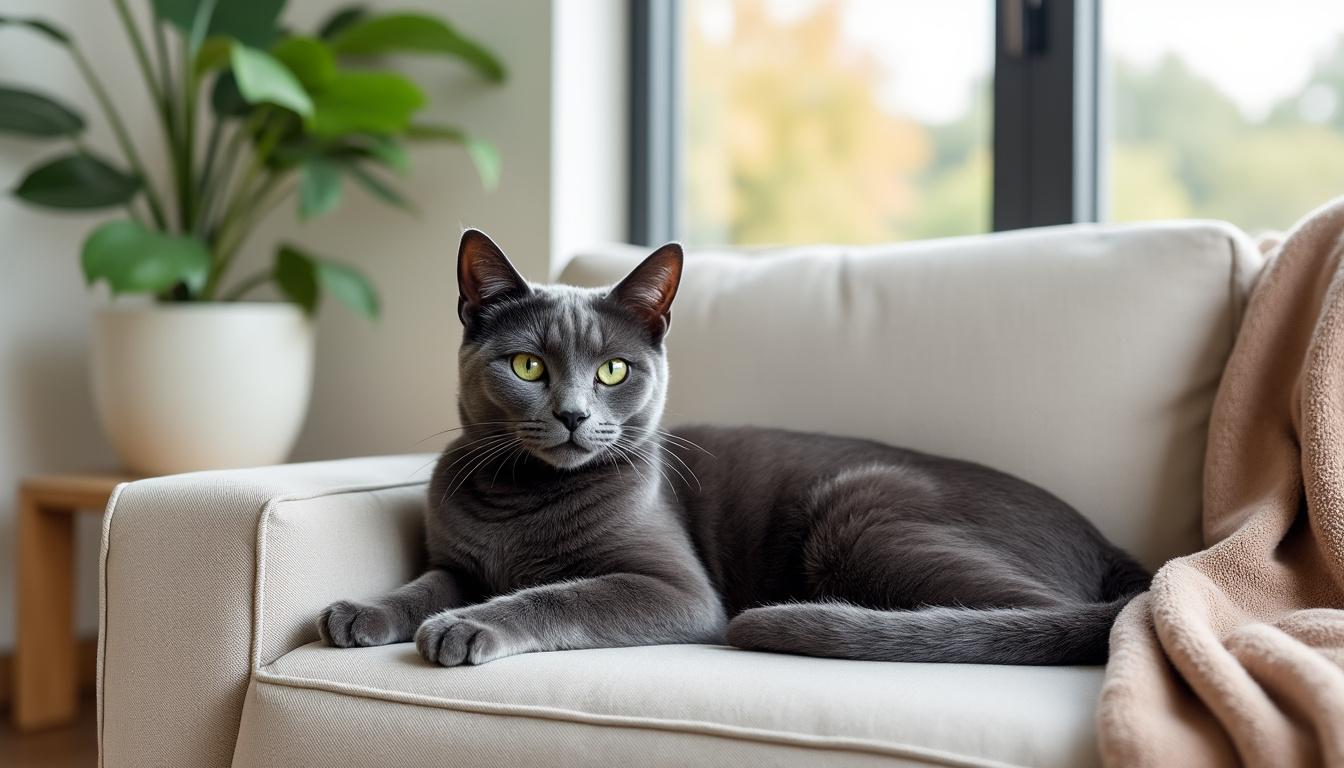If you’re a cat lover but find yourself overwhelmed by shedding, you’re not alone. Many prospective cat owners often wonder which breeds shed the least, as managing fur in the home can be quite a challenge. Various factors contribute to how much a cat sheds, including breed, coat type, and seasonal changes. Understanding these aspects is essential before diving into cat ownership, especially if you are sensitive to allergens or simply prefer a cleaner living space. Moreover, low-shedding breeds tend to come with their own unique characteristics and personalities that can make them even more appealing. This guide will spotlight the most popular cat breeds that shed the least, offering insights into their maintenance, care needs, and striking features.
Brief
- 🌟 Sphynx: The hairless breed with a playful personality.
- 🐱 Bengal: Known for its stunning appearance and minimal shedding.
- 🐈 Russian Blue: Elegant and affectionate with low fur loss.
- ⚡ Devon Rex: Short curls that shed less than many long-haired breeds.
- 💧 Cornish Rex: Similar to Devon Rex, this breed features short hair and playful energy.
- 🏷️ Oriental Shorthair: Sleek and colorful, known for minimal shedding.
- 🏔️ Siberian: Surprisingly low-shedding for a long-haired breed.
- ❤️ Burmese: Affectionate and low-maintenance with little hair loss.
- 🌊 Balinese: Elegantly long-haired yet sheds less.
- 🌬️ LaPerm: Curly coat that reduces shedding significantly.
Understanding Cat Shedding: All About Fur Management
Shedding is a natural process among cats. They shed fur to eliminate old, damaged hair and regenerate a new coat. Each breed has a distinct coat type: some have long flowing locks, while others sport shorter, dense hair. The fundamental elements that contribute to shedding patterns can include genetics, health, diet, and climate. Expert groomers often note that the shedding process is most vigorous during seasonal shifts, particularly in spring and autumn. During these periods, cats lose their undercoats to make way for seasonal changes in their fur.
Factors Contributing to Shedding
There are various factors that dictate how much a cat sheds:
- ☀️ Seasonal Changes: Shedding occurs more during spring and autumn as cats transition from winter to summer coats.
- 🍲 Diet: A well-balanced diet rich in nutrients can promote healthy fur, reducing excessive shedding.
- 🏥 Health Issues: Illnesses or skin conditions can lead to abnormal shedding. Regular vet check-ups can help monitor this.
- 🧼 Grooming: Regular grooming not only manages shedding but also enhances the bond between you and your furry friend.
When discussing different breeds, it’s vital to understand how their coats naturally lend to shedding levels. Some breeds, despite having longer or thicker coats, shed surprisingly little, primarily due to their unique genetic makeup and grooming needs. For instance, the Sphynx, with its lack of hair, is ideal for anyone who dislikes cleaning up fur, while the Bengal offers beautiful markings and minimal shedding.
The Top Low-Shedding Cat Breeds
Now let’s delve into some breeds renowned for their low shedding:
| Breed | Coat Type | Typical Shedding | Grooming Needs |
|---|---|---|---|
| Sphynx | Hairless | None | Weekly wipes to remove oils |
| Bengal | Short | Low | Occasional brushing |
| Russian Blue | Medium | Moderate | Regular brushing |
| Devon Rex | Short | Low | Minimal grooming |
| Cornish Rex | Short | Low | Minimal grooming |
| Oriental Shorthair | Short | Minimal | Occasional brushing |
| Siberian | Medium to Long | Low | Weekly grooming |
| Burmese | Short | Low | Minimal grooming |
| Balinese | Long | Low | Regular grooming |
| LaPerm | Curly | Low | Minimal grooming |
Understanding each breed’s grooming requirements can help you maintain a fur-free home. Not only do these low-shedding breeds provide companionship, but they also require less maintenance compared to those with heavy shedding coats. For prospective cat owners, narrowing your choices down to low-shedding breeds can lead to a compatible and harmonious relationship.

Unique Characteristics of Low-Shedding Breeds
Beyond their grooming and shedding habits, low-shedding cat breeds have unique characteristics that make them alluring as companions. These breeds often possess distinct personality traits that can resonate with specific lifestyles and preferences.
Playful and Affectionate Companions
For example, the Sphynx is not only popular for its hairlessness but also for its sociable nature. This breed thrives on attention and is known to form close bonds with its owners, making it a perfect fit for families or individuals looking for companionship. Similarly, the Bengal, famed for its distinctive coat and energetic demeanor, tends to maintain an active and playful personality, ensuring they keep their owners entertained.
Adaptable and Easy to Train
Many low-shedding breeds are also known for their adaptability and intelligence. The Devon Rex and Cornish Rex, with their playful nature, are often easy to train and adapt well to a variety of environments, whether that be a bustling household or a quieter living space. Investing time in training these breeds can enhance your experience and create a more fulfilling relationship.
Health Considerations
It’s important to note that despite their low shedding advantages, some breeds may come with specific health tendencies. For instance, certain breeds like the Sphynx are more prone to skin issues due to their lack of fur, requiring regular skin care and vet visits. Knowing about these potential health concerns can better prepare prospective owners in providing the best care for their feline friends.
Here’s a brief overview highlighting some unique traits based on breed:
- 🐱 Sphynx: Social, affectionate, seeks attention.
- 🔥 Bengal: Energetic, adventurous, loves interaction.
- 💙 Russian Blue: Gentle, shy yet loving, great for quieter homes.
- 🎭 Devon Rex: Playful and intelligent, enjoys human company.
- 🎉 Cornish Rex: Entertaining and curious, can engage in fun activities.
- 🖌️ Oriental Shorthair: Varied personalities, adaptable and easy to get along with.
- 🏞️ Siberian: Cuddly and gentle, a great family pet.
- 🏡 Burmese: Affectionate and loyal, thrives on companionship.
- 🌈 Balinese: Intelligent and playful, enjoys learning tricks.
- 🌀 LaPerm: Affectionate and easygoing, bonds well with families.
Tips for Managing Cat Shedding and Grooming
While investing in a low-shedding breed can drastically reduce the amount of hair in your home, there are several grooming and care tips that can help maintain an optimal feline-covered environment.
Grooming Techniques
Regular brushing can help minimize shedding even in low-shedding breeds. Here are some effective grooming techniques:
- 🧽 Regular Brushing: Consider brushing your cat weekly or bi-weekly, depending on the breed, to reduce loose fur.
- 🛁 Bathing: Occasional bathing, particularly for hairless breeds, can help in removing excess oils and prevent skin issues.
- 🧴 Skincare: Moisturizing products can be beneficial for breeds like Sphynx, which need skincare due to lack of fur.
- 🔄 Routine vet checkups: Keep an eye on health, especially in breeds prone to specific issues.
Maintaining a Clean Home Environment
Aside from grooming, a few changes around the house can significantly help manage shedding:
- 🧹 Vacuum Regularly: Regular vacuuming prevents hair from accumulating, especially in cat-frequent areas.
- 🧼 Lint Rollers: Keeping a lint roller handy can effortlessly tackle hair on clothing and furniture.
- 🧤 Covers and Throws: Using washable covers on couches or chairs protects your furniture from fur.
- 🌬️ Air Filters: Investing in air filters can capture pet dander and reduce allergens in the environment.
By incorporating these techniques into your routine, you can create a more allergy-friendly home while enjoying the companionship of beautiful, low-shedding fur babies.

Frequently Asked Questions About Low-Shedding Cat Breeds
Do low-shedding cats require more grooming?
Generally, low-shedding cats require less grooming than high-shedding breeds, but regular maintenance is still important to keep their coats and skin healthy.
Are low-shedding cats hypoallergenic?
While no cat is completely hypoallergenic, low-shedding breeds often produce less dander, making them a better option for allergy sufferers.
How can I reduce shedding in my cat?
A balanced diet, regular grooming, and maintaining a healthy lifestyle are crucial for minimizing shedding in any breed.
Which breeds are best for families with young children?
Breeds like the Devon Rex and Burmese often adapt well to family environments due to their friendly and playful nature.
Do all cats shed, regardless of breed?
Yes, all cats shed to some extent, but the amount can vary widely depending on the breed and individual health conditions.

